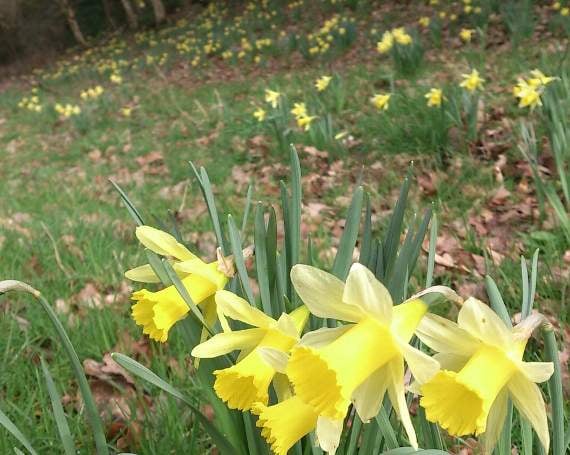ONE of the joys of living in our part of Mid Devon is the sight of wild daffodils which grace the countryside at this time of year. But there are clues in local place-names suggesting that they once grew in very great profusion and, in one location, more than 1,000 years ago.
The native daffodil, Narcissus Pseudonarcissus, which is far more delicate than cultivated varieties, used to be found throughout Britain. But changes in land-use during the 19th century began a substantial decline in numbers and this is true of our locality.
In living memory, children cycled out to pick daffodils from one particular field near Venny Tedburn, and sold them to the Crediton florist ready for Mother’s Day.
But 60 years on, only a few remain. The wild daffodil is the county flower of Gloucestershire because so many once grew in that part of the country. They were picked for selling in Victorian times and, in the 1930s, trains brought people to admire them.
Thanks to the efforts of conservationists and farmers, the famous "Golden Triangle" of wild daffodils that grow in abundance in the fields, verges and woods around Dymock, Kempley and Oxenhall, still exists today.
The older generation will know another name for a daffodil, the dilly, as in the nursery rhyme "Daffy-Down-Dilly". Were Dilly Bridge, and Dillybridge Brook which runs under the A30 near Tedburn St Mary, named after the sight of large numbers of "dillys" appearing in the spring? Or was the meaning as in "dilly and dally" intended?
It is tempting to stretch a point and suggest that nearby Gold’s Cross was named for the colour of daffodils growing in the sun. But there is not much evidence of the daffodils themselves today; a local resident reports that only a few grow along Dillybridge Brook.
There is a second stream which may have got its name from a notable number of daffodils growing beside it.
The wild daffodil flowers during Lent, so it is also known as the Lent lily. We find a Lilly Brook flowing under Lillybrook Bridge, Tedburn St Mary, towards Meetford Cross near Venny Tedburn, where it and the River Ted, join the River Culvery.
Fifteen years ago, at the Meetford end of Lilly Brook, swathes of wild daffodils used to grow in drifts across the fields to the stream, and up into a wood of young oaks. Sadly, there are markedly fewer today.
A local man, who has walked the Tedburn part of Lilly Brook for 20 years, observes only a few daffodils here. If I am correct that the brook was named for the Lent lily, and not after lily of the valley flowers which thrive on chalky soil in dry woodland and hedgerows, nor after an individual - the place-name Lilbourne means "stream of a man called Lilla" - we may be looking at mere remnants of a vast quantity of daffodils which grew here in the past.
Evidence suggesting that Lilly Brook was named for daffodils over 1,000 years ago can be found in an early copy of a charter dated 739AD.
The King of the West Saxons granted land to the Bishop of Sherborne to build a minster at "Cridie". The charter contains an unusually detailed description of the boundary, written mostly in Old English, which travels clockwise around the estate, beginning and ending at a bridge over the river Creedy.
This, along with the fact that many features still exist in the landscape, such as Binneford (beonnan ford) in Sandford, and the sheep brook (scipbrok) now Shobrooke Farm, enabled Della Hooke to map out much of the land given for the minster at Crediton.
Single trees named for individuals serve as boundary markers as do locations of wild animals and birds whose presence in particular places must have been well-known at the time, or at least the name of the place still in use.
Michael Swanton’s translation of the old boundary takes us to Luha’s tree, woodcock hollow, the wolf-trap, fox hollow, the kite’s post, the billy-goat’s ford, the deer pool, the wren’s stronghold and pig hollow.
It is easy to get carried away at the thought of wolves, which did exist in England at the time, being caught in a wulfpyt in our locality, but places were also named after symbolic wolves.
It would be fascinating to see a photographic record of this ancient, Crediton boundary, in particular of the deep pit or hollow which was imagined as the home of Grendel, the monster in the Anglo-Saxon epic poem, “Beowulf”.
Plants such as ivy, ferns and watercress also feature, but only one wild flower, the Lent Lily. We find ourselves walking “from Eagle ridge to the ford in the wooded hollow...to Tettanburn upstream until the Lily brook (lyllan broc)”.
Here is evidence that the stream was known as Lilly Brook in the early eighth century. And if it was named for Lent lilies, the wild daffodils we still see here are all that remain of significant numbers growing over 1,000 years ago.
Does Lilly Brook, with nearby Dilllybridge Brook and Golds Cross, suggest that we have, in the past, had our own "Golden" fields, verges and woods?
Lyn Auty
Crediton





Comments
This article has no comments yet. Be the first to leave a comment.